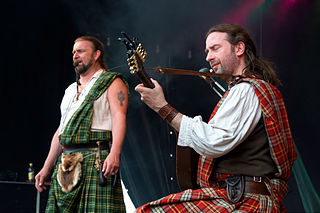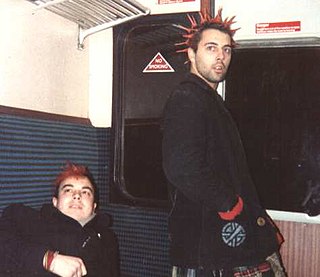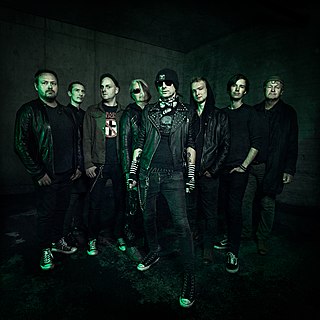Related Research Articles

Celtic music is a broad grouping of music genres that evolved out of the folk music traditions of the Celtic people of Northwestern Europe. It refers to both orally-transmitted traditional music and recorded music and the styles vary considerably to include everything from traditional music to a wide range of hybrids.

Punk fashion is the clothing, hairstyles, cosmetics, jewellery, and body modifications of the punk counterculture. Punk fashion varies widely, ranging from Vivienne Westwood designs to styles modeled on bands like The Exploited to the dressed-down look of North American hardcore. The distinct social dress of other subcultures and art movements, including glam rock, skinheads, greasers, and mods have influenced punk fashion. Punk fashion has likewise influenced the styles of these groups, as well as those of popular culture. Many punks use clothing as a way of making a statement.

Scottish folk music is a genre of folk music that uses forms that are identified as part of the Scottish musical tradition. There is evidence that there was a flourishing culture of popular music in Scotland during the late Middle Ages, but the only song with a melody to survive from this period is the "Pleugh Song". After the Reformation, the secular popular tradition of music continued, despite attempts by the Kirk, particularly in the Lowlands, to suppress dancing and events like penny weddings. The first clear reference to the use of the Highland bagpipes mentions their use at the Battle of Pinkie Cleugh in 1547. The Highlands in the early seventeenth century saw the development of piping families including the MacCrimmons, MacArthurs, MacGregors and the Mackays of Gairloch. There is also evidence of adoption of the fiddle in the Highlands. Well-known musicians included the fiddler Pattie Birnie and the piper Habbie Simpson. This tradition continued into the nineteenth century, with major figures such as the fiddlers Niel and his son Nathaniel Gow. There is evidence of ballads from this period. Some may date back to the late Medieval era and deal with events and people that can be traced back as far as the thirteenth century. They remained an oral tradition until they were collected as folk songs in the eighteenth century.

A cèilidh or céilí is a traditional Scottish and Irish social gathering. In its most basic form, it simply means a social visit. In contemporary usage, it usually involves dancing and playing Gaelic folk music, either at a home or a larger concert at a social hall or other community gathering place.

British rock describes a wide variety of forms of music made in the United Kingdom. Since around 1964, with the "British Invasion" of the United States spearheaded by the Beatles, British rock music has had a considerable impact on the development of American music and rock music across the world.
In the province of Nova Scotia in Canada, Celtic music has played a significant role, both in its traditional forms and fused with other musical styles. Nova Scotia's folk music features traditional tunes brought over from the Scottish Highlands in the late 18th and early 19th centuries, as well as localized forms such as Cape Breton fiddle music. In recent years, a wide variety of other musical genres have emerged in Nova Scotia, which has produced several country music stars such as Hank Snow, Wilf Carter, Anne Murray, and Rita MacNeil.
British folk rock is a form of folk rock which developed in the United Kingdom from the mid 1960s, and was at its most significant in the 1970s. Though the merging of folk and rock music came from several sources, it is widely regarded that the success of "The House of the Rising Sun" by British band the Animals in 1964 was a catalyst, prompting Bob Dylan to "go electric", in which, like the Animals, he brought folk and rock music together, from which other musicians followed. In the same year, the Beatles began incorporating overt folk influences into their music, most noticeably on their Beatles for Sale album. The Beatles and other British Invasion bands, in turn, influenced the American band the Byrds, who released their recording of Dylan's "Mr. Tambourine Man" in April 1965, setting off the mid-1960s American folk rock movement. A number of British groups, usually those associated with the British folk revival, moved into folk rock in the mid-1960s, including the Strawbs, Pentangle, and Fairport Convention.
Celtic rock is a genre of folk rock, as well as a form of Celtic fusion which incorporates Celtic music, instrumentation and themes into a rock music context. It has been prolific since the early 1970s and can be seen as a key foundation of the development of successful mainstream Celtic bands and popular musical performers, as well as creating important derivatives through further fusions. It has played a major role in the maintenance and definition of regional and national identities and in fostering a pan-Celtic culture. It has also helped to communicate those cultures to external audiences.
Folk punk is a fusion of folk music and punk rock. It was popularized in the early 1980s by The Pogues in England, and by Violent Femmes in the United States. Folk punk achieved some mainstream success in that decade. In more recent years, its subgenres Celtic punk and Gypsy punk have experienced some commercial success.
Celtic fusion is an umbrella term for any modern music which incorporates influences considered "Celtic", or Celtic music which incorporates modern music. It is a syncretic musical tradition which borrows freely from the perceived "Celtic" musical traditions of all the Celtic nations, as well as from all styles of popular music, it is thus sometimes associated with the Pan-Celtic movement. Celtic fusion may or may not include authentic traditional music from any one tradition under the Celtic umbrella, but its common characteristic is the inspiration by Celtic identity.

Mícheál Ó Domhnaill was an Irish singer, guitarist, composer, and producer who was a major influence on Irish traditional music in the second half of the twentieth century. He is remembered for his innovative work with Skara Brae, the first group to record vocal harmonization in Irish language songs, and The Bothy Band, one of the most influential groups in Irish traditional music. His reputation was enhanced by a successful collaboration with master fiddler Kevin Burke, and his work with the Celtic groups Relativity and Nightnoise, which achieved significant commercial and critical acclaim.

The Prodigals is an American Irish punk band that started in 1997.

Neck are a six-piece London-Irish Celtic punk band from the North London neighborhood of Holloway led by Leeson O'Keeffe who was a member of Shane MacGowan and the Popes. The band was influenced by two other London bands: The Clash and The Pogues, blending Punk rock with traditional Irish music to play a London-Irish style known as 'Psycho-Cèilidh' where a cèilidh is an Irish social gathering with Gaelic folk music.

Cordelia's Dad is a folk punk band from Northampton, Massachusetts, that combines folk and punk rock influences and was instrumental in the creation of the genre later to be dubbed "No Depression". The band formed in 1987 and was active until 1998, when the members relocated to different parts of the country. After releasing an album of older material in 2002 the band reunited in 2007 for their twentieth anniversary.
A number of overlapping punk rock subgenres have developed since the emergence of punk rock in the mid-1970s. Even though punk genres at times are difficult to segregate, they usually show differing characteristics in overall structures, instrumental and vocal styles, and tempo. However, sometimes a particular trait is common in several genres, and thus punk genres are normally grouped by a combination of traits.

Irish traditional music is a genre of folk music that developed in Ireland.

Celtic Folkweave is a studio album by Mick Hanly and Mícheál Ó Domhnaill, released in 1974 by Polydor Records. Considered a seminal album in the traditional Irish music genre, the musicians involved in the recording would go on to found some of the most innovative and important groups to perform traditional Irish music.
The Dreadnoughts are a Canadian 6-piece folk punk band from Vancouver. The band combines a wide range of European folk music with modern street punk. The band has seven full-length albums and three EPs on various labels, and has played around 500 shows in around 30 countries. They also used to perform before 2020 as a traditional polka band at polka festivals, under the name "Polka Time!". Their performance peak was in 2010, when 180 shows were played.

Greenland Whalefishers, named after the traditional folk tune The Greenland Whale Fisheries, is a Norwegian folk punk band established in 1994, playing music influenced by Celtic traditional music combined with British punk. The musical style of this type of music is also referred to as celtic punk and paddy rock. Greenland Whalefishers are one of the founders of the Celtic punk movement, albeit 10 years after The Pogues.
Drink Hunters is a Catalan band from Barcelona and surroundings. Their music is a mix of punk rock, hardcore punk, folk music and Celtic music with traditional melodies and musical instruments like tin whistle and fiddle. This musical style is commonly called Celtic punk or folk punk. Their lyrics, sung in English, talk about social criticism, diverse historical events, and drinking and partying.
References
- ↑ Ćunković, Milan. "Alfapop". Nadlanu (. Retrieved 6 October 2016.
- ↑ Tabak, Nate; Mullins, Lisa (15 August 2013). "Belgrade's The Orthodox Celts Put Twist on Irish Standards". PRI. Retrieved 6 October 2016.
- 1 2 P. Buckley, The Rough Guide to Rock (London: Rough Guides, 2003), p. 798.
- ↑ B. Sweers, Electric Folk: Changing Face of English Traditional Music (Oxford University Press, 2005), pp. 197-8.
- ↑ Power, Ed (2010-03-17). "Celebrating St Patrick's Day? Don't do it with the Pogues ..." The Guardian. ISSN 0261-3077 . Retrieved 2024-09-10.
- 1 2 Dreadnoughts, The (2022-10-23). "On 'Celtic Punk'". Roll And Go: Dreadnoughts Blog. Retrieved 2024-09-10.
- ↑ "Cordelia's Dad Interviewed by Auger/Anvil". cordeliasdad.com. Retrieved 2024-09-10.
- ↑ Scanlon, A. The Lost Decade. Omnibus Press, 1988
- ↑ J. Herman, ‘British Folk-Rock; Celtic Rock’, The Journal of American Folklore, 107, (425), (1994) pp. 54-8.
- ↑ www.forensicfashion.com http://www.forensicfashion.com/1982CelticPunk.html . Retrieved 2024-09-10.
{{cite web}}: Missing or empty|title=(help) - ↑ McLaughlin, N. and McLoone, M. (2000) "Hybridity and National Musics: The Case of Irish Rock Music." Popular Music 19(2), pp. 181–199.
- ↑ MacÀdhaimh, Seonaidh (19 March 2005). "An dà chòmhlan 'punc' a tha a' seinn sa Ghàidhlig". The Scotsman (in Scottish Gaelic). Edinburgh. Archived from the original on 24 October 2007.